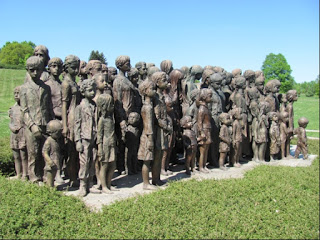Memory of a Tragic Event: Lidice
A few months after the end of the Second World War, I sat proudly next to my war-hero father as Czechoslovakia’s President Eduard Beneš dedicated a memorial to the victims of Lidice. It was a simple cross with a circle of barbed wire, yet its symbolism was overpowering. Three years earlier, Reinhard Heydrich, the Nazis’ Deputy Protector of our country, had been mortally wounded by Czech paratroopers who had been flown in from their base in England as his open car rounded a curve. Heydrich – Hitler’s favorite henchman whose cruelty earned him the moniker, “Butcher of Prague” – survived for several days, but died of blood poisoning brought on by fragments of upholstery, steel, and his own Nazi uniform.
As the Germans staged an elaborate funeral in Berlin, Czechs celebrated, albeit privately and secretly. Their elation did not last long. The Gestapo and the SS hunted down and murdered more than a thousand resistance members and ordinary citizens–anyone suspected of involvement in the assassination – and they deported 3,000 Czech Jews for extermination.
Then, in further revenge, the Germans committed one of the greatest single atrocities of the war, outside the death camps. They concocted a story that the citizens of the small village of Lidice, located near Prague’s Ruzyně airport, had provided assistance to the assassins. This was an outright lie. Lidice consisted of 503 people, 106 houses, a school, a small baroque church; no one in this farming community had a clue about the plot. On June 10, 1942, the Germans shot 172 men and seven women in Lidice. They burned the entire village to the ground, and they shipped 196 women to the Ravensbrück concentration camp, where most died. Most of Lidice’s 96 children were murdered in gas chambers and a few, those who were lucky enough to have Aryan features – blond hair, blue eyes – were put into German orphanages, there to be raised as good Nazis.
On that day in 1945, with returning soldiers who had defeated the Nazis seated with their families in special accommodations, we honored these victims of Lidice. The raising of a stark, simple cross and crown of thorns affected me deeply. The Lidice memorial has the same effect on me today. I am drawn to this place by some invisible magnet each time I visit my native country. There are few visitors to Lidice. Whereas one must fight his way through throngs of tourists armed with cameras at Prague’s castle, Charles Bridge, and Wenceslas Square, a person can find solitude in Lidice. Solitude, and the opportunity to wonder how such cruelty can continue in this world. Will we never learn to live together in peace?
 |
| The martyred children of Lidice |
